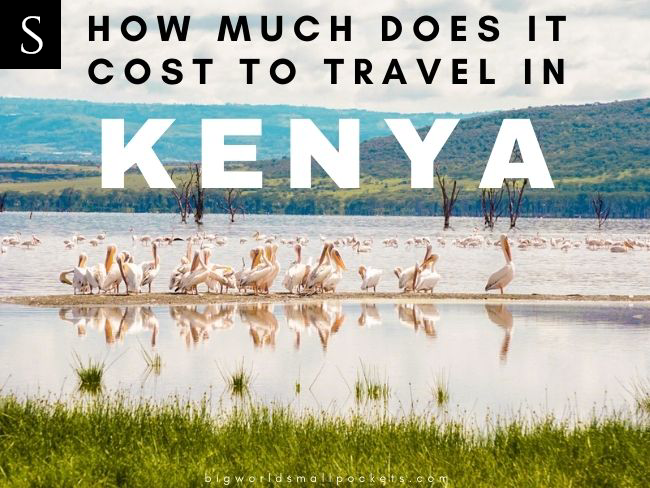
-
Save
Cost Of Travel in Kenya
Kenya remains a good-value destination on the whole. As in any safari country, your most significant expenditure will likely be wildlife tours and accommodation.
Dining, however, remains very affordable even in better places, and public transport is extremely cheap. Museum visits, outdoor excursions, and walking experiences are inexpensive or free. Car rentals are relatively affordable, too.
If you’re on a tight budget, count on spending $30–50 daily. Those on a moderate to mid-range budget can expect to pay $100–150 daily.

-
Save
If you’re on a higher level of spend, count on spending upwards of $200.
Costs also vary according to where you are in the country. They’re lower along the north coast and, to some extent, in Nairobi.
However, staying in Masai Mara’s tented camps or lodges in the plains of Laikipia is not cheap.
Below I’ll break down the average daily budget for traveling Kenya so you have a better idea of what to expect, no matter what your budget might be.
Cost Of Accommodation
Kenya has many accommodation options, from budget hostels and basic city hotels to beach resorts and luxury tented camps hidden in the bundu.
There are also all kinds of campsites, cottages, bandas, and affordable tented camps scattered around national parks and reserves. Prices for these facilities range from $10 to more than $300.
Hotels in Kenya
If you prefer hotels to budget hostels and campsites, you can thrive in Kenya on less than $100 a day per person for full board (room and meals).
- Budget: $15–$35 per night
- Mid-Range: $40–$70 per night
- Top-End: From $100 per night
Hostels in Kenya
The Kenyan coast is considered a backpacker’s trail. This is because there’s so much to do and see on a budget. Also, there are several backpacker hostels in major beach towns like Diani, Mombasa, Kilifi, Watamu, Malindi, and Lamu.
Backpackers and students can enjoy the trail by paying as little as $45 per day ($15 for a dorm bed, $10 for meals, and $20 on activities).
Apartments In Kenya
There are plenty of Airbnb apartments available in Kenya, particularly in Mombasa and Nairobi. You can usually find a nice studio for around $35 per night, a 1-bedroom for $45-$50 per night and luxury 2-bedroom places can run upwards of $300 or more per night.
Cost Of Activities & Tours
There are many fun activities and things to do in Kenya for every budget. Whether you opt for wildlife safaris, diving, local experiences, outdoor excursions, or historical experiences, the country has it all.

-
Save
You’ll pay about $50-$100 for splurge experiences (wildlife safaris), $30-$60 for significant activities (water sports, skydiving), and $10-$35 for minor ones (walking tours, museum visits, and cooking classes), and about $40 for Outdoor activities (zip lining, day hikes).
An overall average of $40 per day works for most people. Make sure you budget more for activities & tours. After all, these are the driving force behind your visit—you came to sightsee, enjoy, and experience Kenya.
Cost Of Food in Kenya
Food is relatively cheap in Kenya, with the average price for meals being $30. But, expensive dishes (like seafood), fine wine, and dessert can significantly increase your final bill.
When restaurant hunting on a budget, choose spots where locals go. This is because they eat higher quality foods at lower prices. While in Nairobi, Kilimanjaro and Ronalo Foods are great options. For less than $10, you can sample local dishes and eat to your fill.
Cost Of Alcohol in Kenya
Tourism goes together with partying, and the nightlife scene is part of the ultimate Kenyan experience. Most bars and nightclubs open at 4 PM, and the fun runs all night. However, alcohol is only sold from 2 to 8 PM in supermarkets. Tusker is hands down the most popular local beer in Kenya. A 500ml bottle costs around $2.5 in a liquor store and $3-5 in bars and hotels.
Although not typical, craft beer is available in big cities like Nairobi. One of the best such beers is Samburu ($4) by 254 Brewing. If you love wine, you’ll find a variety of international wines. Kenya also produces Leleshwa wine, available in camps, lodges, and some hotels.
Besides beer and wine, you’ll find a wide range of international spirits and local drinks like Mnazi (around $1) among the coastal people. You can have a fantastic drinking night in Kenya without spending a lot. Going out with fellow travelers and locals always does the trick.
By sharing costs, ordering in bulk, and taking advantage of discount nights, you can have a great drinking experience for less than $40.
Tipping
Tipping in Kenya is entirely at your discretion, so if you don’t feel you have received sufficient service, feel free not to. However, as a general guideline, below are the typical rates.
Tipping at Restaurants
When eating out at restaurants in Kenya, you can add 10% of the bill as a tip. Alternatively, round up the bill to the nearest Ksh 200 or Ksh 500, depending on the service quality.
Tipping Tour Guides
If you’re happy with the trip, give your van driver or tour guide between $10 to $20 at the end of the safari.
Tipping Housekeeping
When you stay at a hotel in Kenya, it’s a good idea to leave a tip for your hotel room keeper. Count on between $1 and $5 (Ksh 100 – Ksh 500) per night.
Tipping Luggage Handlers
The unofficial tipping rate for Luggage Handlers in Kenya is about Ksh 200. But that’s also up to you.
Tipping Taxi Drivers
Tipping taxi drivers in Kenya is considered a good gesture, even though it’s not expected. You can offer to round up your fare or tip about 10 percent of the total.
Budget ($30-50/day)
Using public transport like Matatus, staying in low-cost accommodation, eating in local restaurants, and joining budget activities, you can keep your daily costs to less than $50.
Mid-Range ($100-150/day)
Going full board in lodges, sleeping in mid-range hotels, eating out often, and doing independent safaris will cost you more than $100 daily.
Top-End ($200+/day)
If you’re the type of traveler who goes full throttle on luxury, Kenya does not disappoint. For more than $200 per day, you can stay in luxury tented camps, take private dhow rides, sleep in top-end hotels, and eat in the best restaurants. The sky is the limit here.
Money Saving Tips For Kenya
Travelers have been visiting different destinations for ages, but it takes a lot of planning to do so on a budget and enjoy the trip simultaneously. But planning is not always enough, and you may need other travel hacks. Traveling to Kenya is no exception. During peak season, huge crowds flock to national parks, increasing safari rates.
Unfortunately, it also drives accommodation facilities to full capacity, making getting a room expensive. To ensure you enjoy all sides of Kenya, from history and culture to wildlife and unique landscapes, look for ways to cut your daily expenditure. To help you brainstorm on that, here are a few money-saving tips you can use when traveling around Kenya.
Opt for Cheap Transport
You’ll most likely arrive in Nairobi by plane. But after that, ditch the fancy means and get savvy right away. Instead of taking a traditional taxi from the airport, hail an Uber. Also, try as much as possible to travel overland between cities. For example, a comfortable first-class seat on a train from Nairobi to Mombasa costs Ksh 3000. A flight for the same journey costs more than Ksh 5,000.
Use Airbnb or Booking.com
Accommodation is one of the most costly traveling expenses in Kenya. Trade expensive hotels and safari lodges for vacation rentals, Airbnb, hostels, and campsites. If you book on these platforms in advance or combine it with my next tip of avoiding peak season, then you can find some pretty significant savings on what will likely be your largest expense when traveling in Kenya.
Visit in The Off-Season
Kenya is a tourist hotspot, there’s no doubt about it. During the peak seasons of July to October and January to February you will find that many hotels are booked up and those that are available have increased their rates. Visit in the off-season or shoulder season and you’ll save money for sure.
Go Local on Meals and Drinks
If you’re on a budget, avoid eating out in expensive restaurants or at expensive hotels. Instead, try local restaurants which, as you’ll discover later in this guide, have the best food and local vibe. Also, try out street food when walking the streets. Not only is this a budget saving tip, but a good way to meet the locals too.
Try Free Things to Do and See
Exploring magical Kenya doesn’t mean you have to spend a fortune. Some of the best money-saving tips on attractions include booking experiences once you arrive, joining local group trips, and traveling off-season. There are equally great free attractions in the country if you’re keen to explore and engage locals.
Haggle for the Best Prices
In Kenya, we like to haggle a little. So, to get the best prices at souvenir markets and certain stores, put your bargaining skills to good use. The rule of thumb in open-air markets like the Masai market is to offer half the price for items. Most of the time, but not always, it will work





